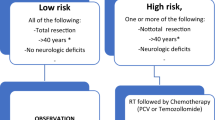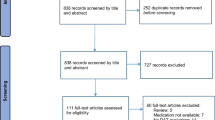Abstract
Peripheral benzodiazepine receptors (PBR) are increased in gliomas and augmented glucose metabolism is seen in malignant brain tumors. We investigated the relationship between PBR density (Bmax) and glucose utilization rate (GUR) in 17 patients with cerebral gliomas of different grades. PBR Bmax was assessed by [3H]PK-11195in vitro binding in surgical specimens and GUR was measured by Positron Emission Tomography with [18F]2-Fluorodeoxyglucose before the surgery. In untreated tumors there was a positive correlation between PBR Bmax and GUR (2r = 0.84). This correlation was not observed in patients who had been treated with radiation and/or chemotherapy prior to surgery (r2 = 0.13). In addition, in untreated patients, the increase in PBR density and GUR appeared to be related to the degree of malignancy.
Similar content being viewed by others
References
Anholt RRH, Pedersen PL, DeSouza EB, Snyder SH: The peripheral type benzodiazepine receptor. Localization to the mitochondrial outer membrane. J Biol Chem 261: 576–583, 1986
Broaddus WC, Bennett JP: Peripheral-type benzodiazepine receptors in human glioblastoma: pharmacologic characterization and photoaffinity labelling of ligand recognition site. Brain Res 518: 199–208, 1990
Black KL, Ikezaki K, Toga AWet al.: Imaging peripheral benzodiazepine receptors in brain tumors in rats:in vitro binding characteristics. J Cereb Blood Flow Metab 10: 580–587, 1990
Black KL, Ikezaki K, Santori Eet al.: Specific high affinity binding of peripheral benzodiazepine receptor ligands to brain tumors in rat and man. Cancer 65: 93–97, 1990
Katz Y, Eitan A, Gavish M: Increase in peripheral benzodiazepine binding sites in colonic adenocarcinoma. Oncology 47: 139–142, 1990
Katz Y, Ben baruch G, Kloog Yet al.: Increased density of peripheral benzodiazepine binding sites in ovarian carcinomas as compared with benign ovarian tumors and normal ovaries. Clin Sci 78: 155–158, 1990
Ferrarese C, Appollonio I, Frigo Met al.: Benzodiazepine receptors and diazepam binding inhibitor in human cerebral tumors. Ann Neurol 26: 564–568, 1989
Benavides J, Cornu P, Dennis Tet al.: Imaging of human brain lesions with an Ω 3 site radioligand. Ann Neurol 24: 708–712, 1988
Black KL, Ikezaki K, Toga AW: Imaging of brain tumors using peripheral benzodiazepine receptor ligands. J Neurosurg 71: 113–118, 1989
Junck L, Olson JMM, Ciliax BJet al.: PET imaging of human gliomas with ligands for the peripheral benzodiazepine binding site. Ann Neurol 26: 752–758, 1989
Di Chiro G, DeLaPaz R, Brooks RAet al.: Glucose utilization of cerebral gliomas measured by [18F]Fluorodeoxyglucose and positron emission tomography. Neurology 32: 1323–1329, 1982
Patronas NJ, Di Chiro G, Kufta Cet al.: Prediction of survival in glioma patients by means of positron emission tomography. J Neurosurg 62: 816–822, 1985
Di Chiro G: Positron emission tomography using [18F]Fluorodeoxyglucose in brain tumors. A powerful diagnostic tool. Inverst Radiol 22: 360–371, 1986
Alavi JB, Alavi A, Chawluket al.: Positron emission tomography in patients with gliomas: a predictor of prognosis. Cancer 62: 1074–1078, 1988
Valk PE, Budinger TF, Levin VAet al.: PET of malignant cerebral tumors after interstitial brachyterapy: demostration of metabolic activity and clinical outcome. J Neurosurg 69: 830–838, 1988
Glantz MJ, Hoffman JM, Coleman REet al.: The role of F18 FDG PET imaging in predicting early recurrence of primary brain tumors. Ann Neurol 29: 347–355, 1991
Zülch KJ: Principles of the new world health organization (WHO) classification of brain tumors. Neuroradiology 19: 59–66, 1979
Di Chiro G, Brooks RA, Patronas NJet al.: Issues in thein vivo measurement of glucose metabolism of human central nervous system tumors. Ann Neurol 15 (Suppl): 138–146, 1984
Phelps ME, Huang SC, Hoffman EJet al.: Tomographic measurement of local cerebral glucose metabolic rate in humans with [18F]2-fluoro-2-deoxy-d-glucose: validation of the method. Ann Neurol 6: 371–388, 1979
Brooks RA: Alternate formula for glucose utilization using labeled deoxyglucose. J Nucl Med 23: 538–539, 1982
Sokoloff L, Reivich M, Kennedy Cet al.: The 14C-Deoxyglucose method for the measurement of local cerebral glucose utilization. Theory procedure and normal values in the conscious and anesthetized albino rat. J Neurochem 28: 897–916, 1977
Le Fur G, Perrier ML, Vaucher Net al.: Peripheral benzodiazepine binding site: effect of PK11195, 1-(2-chlorophenyl)-N-methyl-N-(1-methylpropyl)-isoquinoline carboxamide. Life Sci 32: 1839–1847, 1983
Bradford MM: A rapid and sensitive method for the quantitation of microgram quantities of protein utilizing the principle of protein-dye binding. Analyt Biochem 72: 248–254, 1976
Dominguez JE, Graham JF, Cummins CJet al.: Enzymes of glucose metabolism in cultured human gliomas: neoplasia is accompained by altered hexokinase, phosphofruttokinase and glucose-6-phosphate dehydrogenase levels. Metab Brain Dis 2: 17–30, 1987
Di Chiro G: Brain imaging of glucose utilization in cerebral tumors. In: Sokoloff L (ed) Brain imaging and brain function. Raven Press, NY, 185–197, 1985
Wang JKT, Morgan JI, Spector S: Benzodiazepines that bind at peripheral sites inhibit cell proliferation. Proc Natl Acad Sci USA 81: 753–756, 1984
Wang JKT, Morgan JI, Spector S: Differentiation of Freund erythroleukemia cells induced by benzodiazepines. Proc Natl Acad Sci USA 81: 3770–3772, 1984
Pawlikowski M, Kunert-Radek J, Radek A, Stepien H: Inhibition of cell proliferation of human gliomas by benzodiazepinesin vitro. Acta Neurol Scand 77: 231–33, 1988
Papadopoulos V, Guarneri P, Krueger KEet al.: Pregnenolone biosynthesis in C6-2B glioma cell mithocondria: regulation by a mitochondrial diazepam binding inhibitor receptor. Proc Natl Acad Sci USA 89: 5113–5117, 1992
McEen BS:: Steroid hormones: effect on brain development and function. Horm Res (Suppl)3: 1–10, 1992
McEwen BS: Non-genomic and genomic effects of steroids on neural activity. Trends Pharmacol Sci 12: 141–147, 1991
Kadekaro M, Ito M, Gross PM: Local cerebral glucose utilization is increased in acutely adrenalectomized rats. Neuroendocrinology 47: 329–334, 1988
Daval JL, Post RM, Marangos PJ: Pyruvate dehydrogenase interactions with peripheral-type benzodiazepine receptors. J Neurochem 52: 110–116, 1989
Fields ALA, Cheema-Dhadli S, Wolman SL, Halperin ML: Theorical aspects of weight loss in patients with cancer: possible importance of the pyruvate dehydrogenase. Cancer 50: 2183–2188, 1982
Richfield EK, Ciliax BJ, Starosta-Rubinstein SRet al.: Comparison of [14C]deoxyglucose metabolism and peripheral benzodiazepine receptor binding in rat C6 glioma. Neurology 38: 1255–1262, 1988
Di Chiro G, Oldfield E, Wright DCet al.: Cerebral necrosis after radiotherapy and/or intraarterial chemotherapy for brain tumors: PET and neuropathologic studies. AJNR 8: 1083–1091, 1987
Patronas NJ, Di Chiro G, Brooks RA, DeLaPaz Ret al.: Work in progress: [18F]fluorodeoxyglucose and positron emission tomography in the evaluation of the radiation induced necrosis of the brain. Radiology 144: 885–889, 1982
Doyle W, Budinger TF, Valk PEet al.: Differentiation of cerebral radiation necrosis from tumor recurence by [18F]FDG and82Rb positron Emission tomography. J Comput Assist Tomogr 11: 563–570, 1987
Barril BB, Barril FE, Laszlo J, Wheeler GP: Inibition of rat liver DNA polymerase by nitrosureas and isocyanates. Cancer Res 35: 1–5, 1975
Kohn KW: Interstrand Cross-linking of DNA by 1,3-bis(2-chloroethyl)-1-nitrosurea and other 1-(2-haloethyl)-1-nitrosureas. Cancer Res 37: 1450–1454, 1977
Colvin M, Bundrett RA Jr.: Nitrosureas: current status and new developments, ed. Prestayco AW, Crooke ST, Baker LH, Carter SK, Shein PS. Academic Press 43–49, 1981
Radford IR: Evidence of a general relationship between the induced level of DNA double-strand breakage and cell killing after x-irradiation in mammalian cells. Int J Radiat Biol 49: 611–620, 1986
Chapman JD, Allalunis MJ: Cellular and molecular targets in normal tissue radiation injury. In: Gutin PG, Leibel SA, Sheline GE (eds) Radiation injury to the nervous system. Raven Press, NY, 1: 3–15, 1991
Schneider M, O'Bourke F, Redetzky HM: X-Irradiation and diphosphopiridine Nucleotide (DPN) levels in ascites tumor cells and liver tissue of mice. Int J Radiat Biol 5: 183–189, 1962
Cammarano P: Protein synthesis, glycolisis and oxygene uptake in hepatoma cells irradiatedin vitro. Radiat Res 18: 1–11, 1963
Abe Y, Matsuzawa T, Fujiwara Tet al.: Assessment of radiotherapeutic effects on experimental tumor using [18F]-2-Fluoro-2-deoxy-D-glucose. Eur J Nucl Med 12: 325–328, 1986
Ito M, Patronas NJ, Di Chiro Get al.: Effect of moderate level X-radiation to brain on cerebral glucose utilization. J Comput Assist Tomogr 10: 584–588, 1986
Ogawa T, Uemura K, Shishido Fet al.: Changes in cerebral blood flow, oxigen consumption, glucose metabolism. Following radiochemotherapy of gliomas: a PET study. J Comput Assist Tomogr 12: 290–297, 1988
Kubota K, Ishiwata K, Kubota Ret al.: Tracer feasibility for monitoring tumor radiotherapy: a quadruple study with fluorine-18-fluorodeoxyglucose, fluorine-18-fluorodeossiuridine, L-[Methyl-14C]Methionine, [6-3H]thymidine, and gallium-67. J Nucl Med 32: 2188–2125, 1991
Hoehn-Berlage M, Norris D, Bochorst Ket al.: T1 Snapshot FLASH measurement of Rat brain glioma: kinetics of the tumor-enhancing contrast agent Manganese (III) tetraphenilporphyrine sulfonate. Magn Res in Med 27: 201–213, 1992
Wilmes LJ, Hoehn-Berlage M, Els T, Bochorst Ket al.:In vivo relaxometry of three brain tumors in the rat: effect of Mn-Tpps, a tumor selective contrast agent. J Nuc Mag Res Im 3: 5–12, 1993
Verma A, Nye JS, Snyder SH: Porphyrins are endogenous ligands for the mitochondrial (peripheral type) benzodiazepine receptor. Proc Natl Acad Sci USA 84: 2256–2260, 1987
Author information
Authors and Affiliations
Rights and permissions
About this article
Cite this article
Ferrarese, C., Pierpaoli, C., Linfante, I. et al. Peripheral benzodiazepine receptors and glucose metabolism in human gliomas. J Neuro-Oncol 22, 15–22 (1994). https://doi.org/10.1007/BF01058351
Issue Date:
DOI: https://doi.org/10.1007/BF01058351




